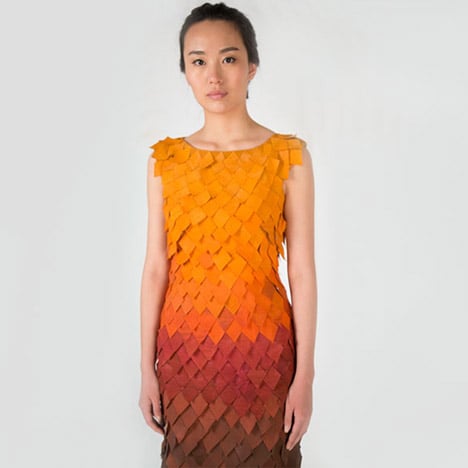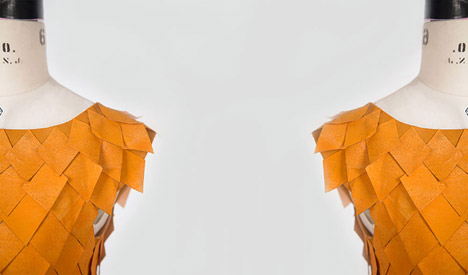Interactive dress by Birce Ozkan drops its panels like autumn leaves
Graduate shows 2015: the Fall dress by fashion design graduate Birce Ozkan loses its fabric panels over time, like a deciduous tree shedding its leaves (+ movie).

Ozkan, who graduated from New York's Parsons The New School for Design this year, created the Fall dress to mimic the natural seasonal responsiveness of trees using a hidden electronic mechanism.
"The behaviour of the garment is inspired by nature's seasonal behaviour of defoliation, the process through which trees naturally lose their leaves," Ozkan said.
The garment is embedded with a sensor that detects low light levels and triggers a reaction, echoing the automatic response of trees to decreasing amounts of daylight in the autumn.

"In the fall, as the days shorten, and the temperature gets colder, the trees, without the light they need to sustain their chlorophyll, shed their leaves to keep their energy to survive for the winter ahead," the designer explained. "This process was the inspiration for creating my garment's mechanism."
"To prepare for the fall of leaves, trees activate 'scissor cells' that split to create a bumping layer that forces the leaves out of place, destabilising them so that they fall," she added.
To recreate this effect, Ozkan incorporated four rotating motors into the cotton dress that forms the base for the design.

The dress is covered with leaf-like muslin panels. Clear tubes are integrated into the garment, wrapping around the body at various heights. Each carries a steel wire that is exposed through small holes at points of contact with the panels, which are attached using wax.
When the sensor identifies low light, the information is interpreted by an Arduino computer circuit that activates the motors. These pull the steel wires sideways, knocking the wax bonds against the edges of the holes and causing the muslin panels to become loose and fall off.

"My thesis project was evolved around the questions: what if when the temperature got hot suddenly, our clothes would start to break apart in response?" explained Ozkan. "What if they had the skill to behave depending on the surrounding conditions? What if garments had the ability to sense the environment just like living organisms?"
The designer spraypainted the muslin in four colours to represent autumnal shades found in nature. This creates a gradient across the laser-cut fabric panels, which blends from yellow at the top of the dress to brown at the bottom.
"I used mimicry to capture the beauty of falling leaves and I believe that the piece will make audiences appreciate the natural world," Ozkan said. "This piece opens new ways of creating wearable technology not just to serve a functional purpose, but also to create artistic, performative and expressive pieces."
Photographs and movie are by Rebecca Enis.